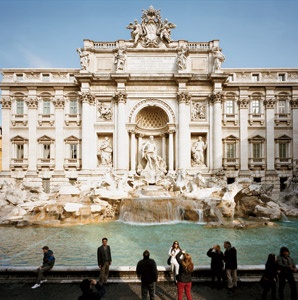 Across the euro-strapped continent, centuries-old treasures are falling apart—and there’s no easy way to repair the damage. What will it take to preserve these European landmarks?
Across the euro-strapped continent, centuries-old treasures are falling apart—and there’s no easy way to repair the damage. What will it take to preserve these European landmarks?
The crowds surrounding the Trevi Fountain in Rome behaved as if nothing were amiss. They snapped photos and ate gelato in its shadow, even though a third of the backdrop to the fabled landmark was sheathed in plastic and scaffolding after chunks of sculpted stone suddenly fell off last June.
Just behind the fountain depicting Neptune on a winged chariot stands an 18th-century palazzo housing the National Institute of Graphic Arts, which holds works by such masters as Giambattista Piranesi, Antonio Canova, and Giorgio Morandi. It contains one of Europe’s leading art collections, but the works are rarely exhibited due to lack of funding.
Culture is under assault across Europe, and nowhere is this more acute than in the struggling economies of Italy, Greece, and Spain, which also have the lion’s share of the Continent’s European landmarks, with more than 100 UNESCO World Heritage sites combined. Galleries at museums are closing, thefts of precious artworks are increasing, and centuries-old buildings are crumbling. “Such an immense heritage requires money and maintenance,” Salvatore Settis, former head of Italy’s National Heritage Council and director of the Getty Research Institute, in Los Angeles, told me on a recent trip to Rome. “Both have been neglected, so European landmarks are going to continue to fall down.”
In Italy, government spending on the arts has been slashed drastically since 2010. At the ancient ruins of Pompeii, a portion of the wall surrounding the city fell down last year because of water damage and still hasn’t been restored. In Venice, empty coffers have hampered efforts to preserve the cityscape in the face of seawater, pollution, and hordes of tourists. The columns lining Piazza del Plebiscito, in Naples, are covered in graffiti. In Spain, parts of Granada’s Alhambra and the Medina al-Zahra, in Córdoba, are in a state of ruin.
Greece’s rich archaeological legacy is perhaps even more at risk. Dozens of top archaeologists have recently been pushed into retirement, and with far fewer custodians of history, future real estate development may end up damaging artifacts on historic sites: take the southern region of Messenia, where excavation work on a sixth-century-B.C. temple was halted in 2012. Earlier this year, the Museum of Olympia was stormed by a gunman who escaped with more than 70 works of art because of a lack of security; cuts were also blamed for recent thefts of Picasso and Mondrian paintings from the National Gallery, in Athens.
“It’s distressing,” says Bonnie Burnham, president of the World Monuments Fund. “European countries aren’t set up to pursue alternative strategies when they don’t have budgets.” What’s more, she points out, there are no tax incentives to encourage private philanthropy. Enter corporate sponsors. Rather than following traditional models of donating behind the scenes through cultural organizations, they are spearheading restoration efforts themselves in exchange for opportunities to advertise. Wander through Venice and you may see huge Coca-Cola banners hanging near Piazza San Marco; for months, the white limestone façade of the Bridge of Sighs was covered in a tarp touting the women’s clothing line Sisley. Later this year, a reported $33 million renewal project sponsored by shoemaker Tod’s is set to begin on Rome’s Colosseum: under the contract, the company will have the right to use the Colosseum’s logo for 15 years and travelers can expect to see the Tod’s brand on the ticket they buy to visit the historic site.
Many locals believe it’s a small price to pay to ensure that European landmarks remain open, but others feel the negotiation turns culture into merchandise. “The scope of Michelangelo and Caravaggio is not to create money for business, but civilization for all the nation,” Italian historian and art critic Tomaso Montanari says. The good news? While European governments pull back, most privately funded cultural preservation groups have managed to survive and are cautiously optimistic about the future. Save Venice, for example, is moving forward with more than 30 restoration projects this year, says Melissa Conn, director of the Venice office. At the Gallerie dell’Accademia, the organization has pioneered the restoration of the Sala dell’Albergo, which includes Titian’s Presentation of the Virgin in the Temple and paintings by his contemporaries that had been kept in storage for more than a century. According to Conn, “Europeans will never abandon their cultural heritage.”
These not-for-profits are helping with restoration projects across the continent.
World Monuments Fund Heavyweight advocate for the preservation of endangered historical sites worldwide and community rebuilding. wmf.org.
Save Venice One of the world’s largest organizations solely dedicated to restoring Venice’s art and architecture. savevenice.org.
Italia Nostra Campaigns to protect and promote Italy’s historical, environmental, and cultural institutions. italianostra.org.
English Heritage Manages the conservation of more than 400 castles, abbeys, and other monuments in England. english-heritage.org.uk.
La Société des Amis de Versailles Raises funds to refurbish and maintain France’s Palace of Versailles. amisdeversailles.com.